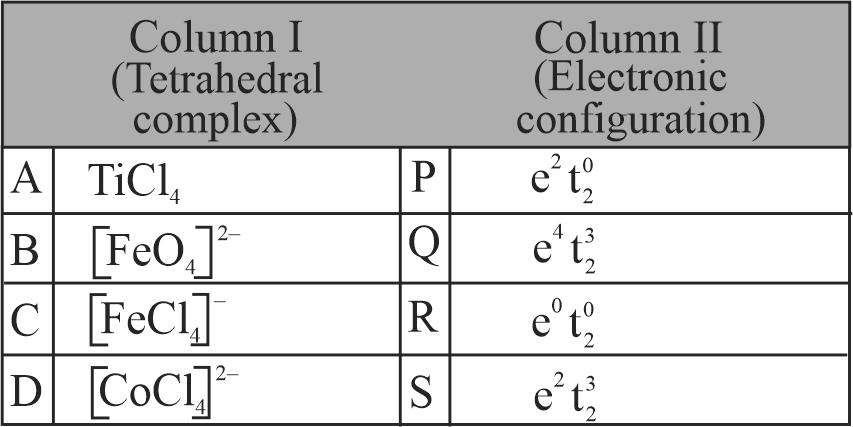321853
Which of the following statements are correct?
(I) In octahedral complexes,\({{\text{d}}_{{{\text{z}}^{\text{2}}}}}{\text{,}}{{\text{d}}_{{{\text{x}}^{\text{2}}}{\text{ - }}{{\text{y}}^{\text{2}}}}}\) orbitals have higher energy than \({{\text{d}}_{{\text{xy}}}}{\text{,}}{{\text{d}}_{{\text{yz}}}}{\text{and}}\,{{\text{d}}_{{\text{zx}}}}\) orbitals.
(II) In tetrahedral complexes,\({{\text{d}}_{{\text{xy}}}}{\text{,}}{{\text{d}}_{{\text{yz}}}}{\text{,}}{{\text{d}}_{{\text{zx}}}}\) orbitals have higher energy than \({{\text{d}}_{{{\text{z}}^{\text{2}}}}}\,{\text{and}}\,\,{{\text{d}}_{{{\text{x}}^{\text{2}}}{\text{ - }}{{\text{y}}^{\text{2}}}}}\) orbitals.
(III) The colours of complexes are due to electronic transitions from one set of \({\text{d}}\) orbitals to another set of \(\mathrm{d}\) - orbitals.
(Iv) \(\Delta_{\text {tetrahedral }}=\dfrac{9}{4} \Delta_{\text {octahedral }}\)
321853
Which of the following statements are correct?
(I) In octahedral complexes,\({{\text{d}}_{{{\text{z}}^{\text{2}}}}}{\text{,}}{{\text{d}}_{{{\text{x}}^{\text{2}}}{\text{ - }}{{\text{y}}^{\text{2}}}}}\) orbitals have higher energy than \({{\text{d}}_{{\text{xy}}}}{\text{,}}{{\text{d}}_{{\text{yz}}}}{\text{and}}\,{{\text{d}}_{{\text{zx}}}}\) orbitals.
(II) In tetrahedral complexes,\({{\text{d}}_{{\text{xy}}}}{\text{,}}{{\text{d}}_{{\text{yz}}}}{\text{,}}{{\text{d}}_{{\text{zx}}}}\) orbitals have higher energy than \({{\text{d}}_{{{\text{z}}^{\text{2}}}}}\,{\text{and}}\,\,{{\text{d}}_{{{\text{x}}^{\text{2}}}{\text{ - }}{{\text{y}}^{\text{2}}}}}\) orbitals.
(III) The colours of complexes are due to electronic transitions from one set of \({\text{d}}\) orbitals to another set of \(\mathrm{d}\) - orbitals.
(Iv) \(\Delta_{\text {tetrahedral }}=\dfrac{9}{4} \Delta_{\text {octahedral }}\)
321853
Which of the following statements are correct?
(I) In octahedral complexes,\({{\text{d}}_{{{\text{z}}^{\text{2}}}}}{\text{,}}{{\text{d}}_{{{\text{x}}^{\text{2}}}{\text{ - }}{{\text{y}}^{\text{2}}}}}\) orbitals have higher energy than \({{\text{d}}_{{\text{xy}}}}{\text{,}}{{\text{d}}_{{\text{yz}}}}{\text{and}}\,{{\text{d}}_{{\text{zx}}}}\) orbitals.
(II) In tetrahedral complexes,\({{\text{d}}_{{\text{xy}}}}{\text{,}}{{\text{d}}_{{\text{yz}}}}{\text{,}}{{\text{d}}_{{\text{zx}}}}\) orbitals have higher energy than \({{\text{d}}_{{{\text{z}}^{\text{2}}}}}\,{\text{and}}\,\,{{\text{d}}_{{{\text{x}}^{\text{2}}}{\text{ - }}{{\text{y}}^{\text{2}}}}}\) orbitals.
(III) The colours of complexes are due to electronic transitions from one set of \({\text{d}}\) orbitals to another set of \(\mathrm{d}\) - orbitals.
(Iv) \(\Delta_{\text {tetrahedral }}=\dfrac{9}{4} \Delta_{\text {octahedral }}\)
321853
Which of the following statements are correct?
(I) In octahedral complexes,\({{\text{d}}_{{{\text{z}}^{\text{2}}}}}{\text{,}}{{\text{d}}_{{{\text{x}}^{\text{2}}}{\text{ - }}{{\text{y}}^{\text{2}}}}}\) orbitals have higher energy than \({{\text{d}}_{{\text{xy}}}}{\text{,}}{{\text{d}}_{{\text{yz}}}}{\text{and}}\,{{\text{d}}_{{\text{zx}}}}\) orbitals.
(II) In tetrahedral complexes,\({{\text{d}}_{{\text{xy}}}}{\text{,}}{{\text{d}}_{{\text{yz}}}}{\text{,}}{{\text{d}}_{{\text{zx}}}}\) orbitals have higher energy than \({{\text{d}}_{{{\text{z}}^{\text{2}}}}}\,{\text{and}}\,\,{{\text{d}}_{{{\text{x}}^{\text{2}}}{\text{ - }}{{\text{y}}^{\text{2}}}}}\) orbitals.
(III) The colours of complexes are due to electronic transitions from one set of \({\text{d}}\) orbitals to another set of \(\mathrm{d}\) - orbitals.
(Iv) \(\Delta_{\text {tetrahedral }}=\dfrac{9}{4} \Delta_{\text {octahedral }}\)

